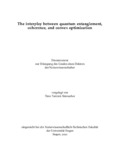Citation link:
http://dx.doi.org/10.25819/ubsi/9981Files in This Item:
| File | Description | Size | Format | |
|---|---|---|---|---|
| Dissertation_Timo_Simnacher.pdf | 3.31 MB | Adobe PDF |  View/Open |
| Dokument Type: | Doctoral Thesis | metadata.dc.title: | The interplay between quantum entanglement, coherence, and convex optimization | Other Titles: | Das Zusammenspiel zwischen Quantenverschränkung, Kohärenz und konvexer Optimierung | Authors: | Simnacher, Timo Yannick | Institute: | Department Physik | Free keywords: | Quantum information, Entanglement, Convex optimization, Semidefinite programming, Coherence | Dewey Decimal Classification: | 530 Physik | GHBS-Clases: | UHEQ UHED |
Issue Date: | 2021 | Publish Date: | 2021 | Abstract: | In this thesis, we strive to advance the knowledge of relations between convex optimization and the quantum phenomena entanglement and coherence. The main research areas we explore are rank-constrained semidefinite programming, the quantum pure-state marginal problem and the existence of AME states as well as quantum codes, entanglement detection, and the certification of quantum memories with coherence. First, we start with real and complex rank-constraint semidefinite optimization problems and rephrase them as an optimization over separable two-copy states. This reformulation allows to approach the problem through a hierarchy of efficiently solvable semidefinite programs that provide better and better certified bounds. We apply the new technique to various problems in quantum information theory and beyond, such as the optimization over pure states or unitary channels and the well-known maximum cut problem. Furthermore, we describe an inherent symmetry in our formulation that significantly improves the performance. Second, we consider the application of our method to the quantum pure-state marginal problem. In particular, we prove that the existence of n-partite absolutely maximally entangled states with local dimension d is equivalent to the bipartite separability of a certain state of 2n particles, and we compute that state explicitly. This application is a striking example of how symmetries can simplify semidefinite programs and we use them to compute high orders of our hierarchy despite the rapidly increasing dimension. Moreover, we rewrite the existence problem of quantum error-correcting codes as a marginal problem making our method also applicable to this area of research. Third, since entanglement is not only a theoretically interesting phenomenon, but also a vital resource for quantum information protocols, we investigate entanglement detection in practical experiments. We examine scrambled data, a scenario in which the mapping between outcomes and their respective probabilities is lost. Furthermore, we use the joint numerical range of observables to find measurements that allow entanglement detection even when the confidence region due to statistical and systematic errors is large. Finally, we introduce a quality measure for quantum memories that quantifies the performance based on the memory’s ability to preserve coherence. Remarkably, this measure also distinguishes entanglement-breaking channels from genuine quantum memories. For the case of single-qubit channels, we find various theoretical bounds and a simple measurement scheme to approximate our performance measure. Mit dieser Dissertation wollen wir das Verständnis der Zusammenhänge zwischen konvexer Optimierung und der Quantenphänomene Verschränkung und Kohärenz erweitern. Die Hauptforschungsgebiete, die wir erkunden, sind rangbeschränkte semidefinite Programmierung, das Marginalproblem reiner Quantenzustände und die Existenz von AME-Zuständen sowie Quantencodes, Verschränkungsdetektion und die Zertifizierung von Quantenspeichern mittels Kohärenz. Als erstes beschäftigen wir uns mit reellen und komplexen rangbeschränkten semidefiniten Optimierungsproblemen und formulieren diese als Optimierung über separierbare Zwei-Kopien-Zustände um. Das erlaubt es, mittels einer Hierarchie effizient lösbarer semidefiniter Programme immer bessere zertifizierte Schranken zu berechnen. Wir wenden die Methode auf verschiedene Probleme in der Quanteninformationstheorie an, wie etwa die Optimierung über reine Zustände oder unitäre Kanäle und das Problem des maximalen Schnitts eines Graphen. Außerdem beschreiben wir eine inhärente Symmetrie unserer Formulierung, die die Komplexität erheblich verringert. Dann wenden wir unsere Methode auf das Marginalproblem reiner Quantenzustände an. Insbesondere beweisen wir, dass die Existenz n-partiter absolut maximal verschränkter Zustände mit lokaler Dimension d äquivalent zu der bipartiten Separierbarkeit eines bestimmten 2n-Teilchenzustands ist, den wir explizit berechnen. Das zeigt eindrucksvoll, wie Symmetrien semidefinite Programme vereinfachen können, sodass hohe Ordnungen unserer Hierarchie trotz rasch steigender Dimension berechenbar sind. Ferner formulieren wir das Existenzproblem von Quantenfehlerkorrekturcodes als Marginalproblem, sodass unsere Methode auch hierfür anwendbar wird. Da Verschränkung nicht nur theoretisch interessant ist, sondern auch eine essentielle Ressource für Quanteninformationsprotokolle, erforschen wir anschließend deren Detektion in der Praxis. Wir untersuchen ein Szenario, bei dem die Zuordnung von Messergebnissen zu den entsprechenden Wahrscheinlichkeiten unklar ist. Außerdem nutzen wir das gemeinsame numerische Bild von Observablen, um Messungen zu finden, die Verschränkungsdetektion selbst dann ermöglichen, wenn die Konfidenzregion aufgrund statistischer und systematischer Fehler relativ groß ist. Abschließend stellen wir ein Qualitätsmaß für Quantenspeicher vor, das die Leistungsfähigkeit auf Basis von Kohärenzerhaltung misst. Bemerkenswerterweise differenziert das Maß auch zwischen verschränkungszerstörenden Kanälen und echten Quantenspeichern. Für Ein-Qubit-Kanäle beschreiben wir theoretische Schranken und einfache Messungen, um das Maß näherungsweise zu bestimmen. |
DOI: | http://dx.doi.org/10.25819/ubsi/9981 | URN: | urn:nbn:de:hbz:467-19677 | URI: | https://dspace.ub.uni-siegen.de/handle/ubsi/1967 |
| Appears in Collections: | Hochschulschriften |
This item is protected by original copyright |
Page view(s)
497
checked on Nov 28, 2024
Download(s)
581
checked on Nov 28, 2024
Google ScholarTM
Check
Altmetric
Items in DSpace are protected by copyright, with all rights reserved, unless otherwise indicated.

